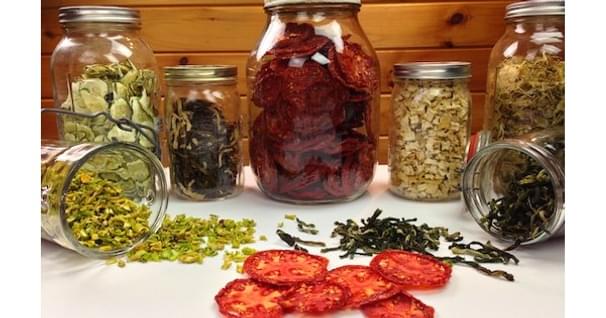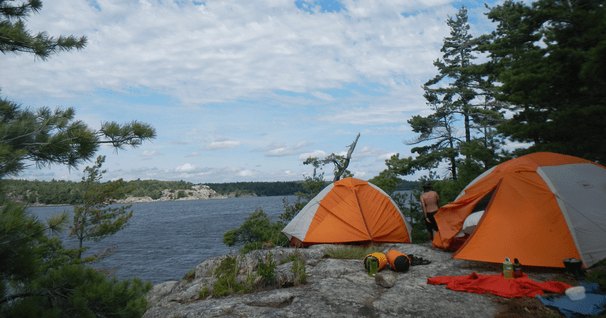Kitchen Supplies
When it comes to cooking in the outdoors, you can't do good work without good tools. Badly designed, flimsy cookware won't do. Unfortunately, most pots and pans you buy for camping are awful.
Note: I receive no royalties for suggesting certain products, even ones I designed. In fact, many of the items I recommend in my books came about only after I badgered manufacturers to produce them to my own high standards. When I find something I really like, I want to share it with my friends.
For a party of four, you'll need the following gear:
Three nesting pots with covers. Pots may be aluminum, stainless steel, or porcelain-lined carbon steel. I prefer stainless because it resists dents and is easy to clean. Where weight and bulk is a primary concern, the kit can be reduced to two pots. Some backpackers travel with only a single pot. Two-and-one-half cups of hot food is a reasonable serving size for a hungry camper. Your largest pot should have a sixteen-cup capacity so you can cook pasta without gluing it to the bottom.
Tip: Engrave lines on the inside pot sides at one-cup intervals and write the total capacity (e.g. sixteen cups) just below the rim. This forethought will eliminate guesswork and the need for measuring cups at mealtime.
For faster and more even heating, you may want to blacken aluminum pot bottoms. A few sessions over a campfire will do it and so will Alumablack-a chemical agent used for darkening aluminum gun parts. Similar to "cold blue," every gun shop has it.
One relatively straight-side 10- or 12-inch diameter, Teflon-Lined skillet. You need one skillet for every five people. Or, you can bring a grill that spans two stoves. Skillets and grills should be Teflon (or similar substance) coated, carbon steel, or stainless with copper bottom. Pure aluminum is an abomination unless it is very thick. Avoid the flimsy Teflon-lined pans with folding handles that are sold in camping shops. I purchase a high-grade, Teflon-lined skillet and replace the plastic handle with a removable one, which I bend from 0.187-inch-diameter spring wire. The mounting bracket for the handle is made from hardware store aluminum flat stock. It secures with two brass bolts that are easily removed when the pan wears out. I also outfit some of my pots with these rigid wire handles.
I recently encouraged Kevin Carr of Chosen Valley Canoe Accessories to make a handle kit for those who don't want to make their own (contact him at 507-867-3961, or e-mail k2carr@aol.com).
Eight-cup coffeepot or kettle. A wide-based kettle heats faster and is less tippy than a coffeepot, and you can pour with one hand. Pack onions, green peppers, cheese, and other crushable/ breakables inside your empty kettle.
An oven of some sort. Specialized trail ovens, such as the efficient Bakepacker, are nice, but they're excess baggage on a go-light trip. You can easily improvise a convection oven from existing cookware. Chapter 6, The Art of Baking, shows how.
Two nesting stainless-steel Sierra cups, for use as compact ladles and emergency drinking cups. Steel cups won't warp or melt when you set them on a stove, or by the campfire to heat tea.
One nesting bowl per person. Metal bowls are heavy and they transfer heat to your hands. Plastic bowls are cooler and easier to clean. Why doesn't someone make a stainless steel bowl with a removable, heat-resistant plastic bottom? Bowls should be colored or numbered so that each person will always use the same one. This eliminates sharing germs at meals. Keep nested cookware inside a fitted nylon sack.
Individual items. If you want to go light, one metal spoon per person is enough. Gourmet cooks will add a fork. Everyone carries their own knife and insulated mug. Be sure the mug has a fitted cover to keep heat in and heat-seeking insects out. Leash the cover to the mug with a piece of fishing line.
Fabric utensil roll. Buy one from the Duluth Tent & Awning Company in Minnesota (800-849-4489) or make your own. Be sure the roll has snaps or ties on top, so you can hang it from a clothesline. Chapter 7 shows why.
My utensil roll contains: one plastic pancake turner, one wooden spoon, one rubber spatula, one wooden spatula, one miniature cheese grater, two bamboo tongs, one utility knife (I like the folding carbon-steel "French picnic knife," which costs under $10 at outdoor stores), one tiny wire strainer (1-inch diameter screen) for straining coffee grounds, and four removable wire pot handles.
Spice bag. I carry small containers of nearly every spice known to man. My favorites are cayenne, garlic, cumin, oregano, basil, thyme, lemon pepper, and Old Bay Seasoning. No one will fault you for bringing too many spices on a backwoods camping trip.
Two-quart, graduated plastic pitcher. This is convenient for mixing powdered drinks, pancake mixes, and instant puddings as well as for hauling water to the cooking site.
Dishwashing materials. A four-ounce bottle of liquid detergent, a plastic sponge, and one abrasive and one non-abrasive 3-M nylon scratcher are all you need. I use synthetic chamois towels for drying dishes and mopping up spills.
Dish sterilization materials. You can sterilize camp dishes by adding a splash of chlorine bleach to the final rinse water. Or add a convenient Effersan tablet. Effersan tablets have 30 percent available chlorine in a handy dry form (Effercept Products, Inc., 800-841-0410).
Insulated cozies for your pots. When it's cold and windy, you'll want insulated fabric cozies, like the ones grandma used to keep her teapot warm. Chapter 7, Cooking Tricks, shows how to make and use cozies. You may want to read this section before you tackle Chapter 3.
One thin-bladed sheath knife with a 4- to 5-inch-long flat-ground blade. Try to spread jam, scrape peanut butter from the bottom of a poly bottle, or slice lunch meat or cheese with a common jackknife or husky "deer skinner" and you'll see why a thin, fixed-blade knife is so important. My favorite trail knife is the "Cliff Knife," which I designed when I couldn't find a suitable replacement for my worn out tool-steel Gerber shorty. It has a wafer-thin, 4.3-inch blade of L6 tool steel and it's custom made by Idaho Knife Works (509-994-9394).
Gasoline stove. Ideally, you should have one bumer for every four people. Of course you can cook on a fire (where permitted), but weather frequently makes this impractical.
Excerpted from Basic Essentials™ Cooking in the Outdoors by Cliff Jacobson with permission from Falcon Publishing. www.cliffcanoe.com
Related Articles
For many years I've been an avid sea kayaker who resisted the temptation to dehydrate my food before any…
In 1971, I outfitted and guided three wealthy Chicago men--the least affluent of which earned a quarter…
Kayak camping is not all that different than backpacking - if anything it is easier as you don't have to…
When it's finally time to go on a weekend paddling trip or to experience the pure freedom of a…



